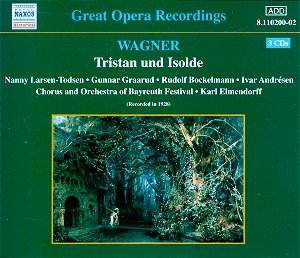The Wagner recording wars of the 1920s between
HMV and Columbia led to some permanently important additions to
the discography. Columbia succeeded in ousting their rivals from
the Bayreuth Festspielhaus in 1927 and technicians from the English
branch travelled there to record first excerpts from Parsifal
and then in 1928 most of Tristan. Whilst experimental in-concert
performances had of course been made before, it was technically
too difficult to record during performance in Bayreuth so the
discs were made when the hall was empty of audience. It remains
the most complete Wagner opera set to have been made in the 78
era.
The Tristan was Gunnar Graarud, born near Oslo
in 1886, and a member of the Vienna State Opera between 1929 and
1937. His Isolde was Nanny Larsen-Todsen, two years older and
a fellow Scandinavian, whose career was truly international in
scope. She had made her debut in Stockholm in 1906 and went successively
to La Scala, the Met in New York and Bayreuth, where she was starring
at the time of this Tristan recording. She sang at Covent Garden
in 1927 and 1930 and had a successful teaching career, living
to the grand age of ninety-eight. Bockelmann needs little introduction;
I hadn’t realised he’d been wounded several times during active
service in World War I but the philology student, whose career
was a splendidly successful one, never made quite the number of
recordings commensurate with his exceptional talent. Ivar Andrésen
appears twice as King Marke, firstly in the Bayreuth-Columbia
set and again in the HMV set of extracts from Act III. As with
Graarud, he was born in Oslo, another in the great cadre of Scandinavian
singing stars of the Wagnerian discography. He was the reigning
basso in Dresden, a magnificent Verdi and Wagner singer, a regular
at Bayreuth, visitor to the Met and guest artist across Europe.
He died, miserably young, at forty-four. And then there was Elmendorff
who, like his Kurwenal, studied philology. He came up the German
way, taking provincial appointments and learning from the inside,
until his long stint from 1927-42 at Bayreuth where he was also
recorded in Tannhäuser. During the war he was in Dresden
and a number of radio recordings have emerged from this period.
Adherents of the 78 may remember with admiration his recording
of von Einem’s Concerto for Orchestra and then those later wartime
vintage series of discs, such as Der Corregidor, Luisa Miller,
Don Giovanni and Goetz’s Taming of the Shrew.
This was not a first choice cast. Frida Leider
and Lauritz Melchior were HMV artists and so were not contractually
available. The First Act is substantially intact and Larsen-Todsen
proves to be a singer of all round flair here, maybe preferable
to her Tristan, even though Elmendorff’s tempi can be energisingly
brisk and might have hurried Graarud a little. Act II is pretty
much complete – there are two little cuts – and here he comes
into his own, singing with considerable intensity, and conjoining
with her in a love duet of real depth, surely one of the greatest
on disc before the LP era. Elmendorff’s sure accomplishment, his
command of rubati and the long line enable the cast to inflect
freely and confidently. Andrésen’s black voiced Marke for
example is an impressively introspective impersonation (but he
was even more impressive the previous year for Albert Coates).
Bockelmann’s voice was always more baritonal then one might have
expected and it gave him a flexibility denied to his strictly
bass contemporaries. It allowed him an upward extension that added
greatly to the colour and mobility of his singing and it’s one
of the talking points of this set. Act III was rather drastically
cut and little sense can be made of it, even though the rationale
– conserving the energy and voices of the singers on concert nights
– has some kind of logic. The orchestra plays with commendable
skill and virtuosity under Elmendorff.
The 1927 assemblage of Act III was made in London
and conducted by the incendiary Anglo-Russian Albert Coates, Leo
Blech (one side) and Lawrance Collingwood. The Tristan and Isolde
were Walter Widdop and Göta Ljungberg. He was Britain’s leading
inter-War heldentenor and a Handelian of epoch shattering greatness
and she was yet another Scandinavian, a Swede from Sundsvall.
A decade long period of international celebrity was inaugurated
by a famous Covent Garden premiere in 1924 but her career later
petered out. Widdop, whom sleeve note writer Tully Potter rashly
– or bravely – calls Britain’s leading tenor of the period brings
a noble gravity and simplicity to Hei nun! in his meeting
with Kurwenal – sung by three singers, so complicated were the
ramifications of the recording schedule - Howard Fry, Charles
Victor and Edward Habich. Fry sings the earlier part (Fry was
Widdop’s teacher), Victor the "middle" section and Habich,
later a noted star at the Met, sings the Scene III part. I should
also mention the oft overlooked but excellent Brangäne of
Genia Guszalalewicz.
Because of the excellence of the original recordings
– made in the Festspielhaus and in Queen’s Hall – the only real
transfer imperatives were side joins and pitch fluctuation, both
of which have been achieved with impeccable accuracy. There is
a rival version on Malibran, which I’ve not heard but I can strongly
recommend this budget price Naxos contender.
Jonathan Woolf

